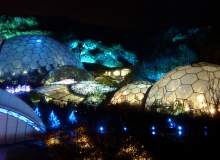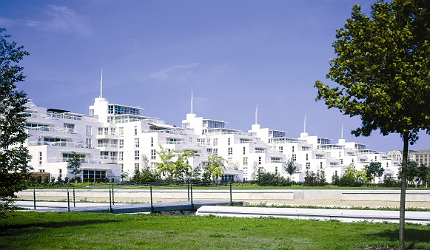

For centuries, humanity’s deep thinkers have drawn inspiration from the natural world to drive forward some of the world’s big ideas. On a conceptual level, nature provides a physical canvas that can help us visualise the unseen forces of the world, as with Archimedes’ fateful plunge into the bathtub or Isaac Newton’s apple-assisted breakthrough on gravity.
Many of nature’s great mysteries have now offered up their secrets, but the observation of natural processes still holds great potential for a number of design and materials engineering fields. In the last 50 years or so, nature has inspired some of the world’s most ingenious biomimetic materials, from Percy Shaw’s ‘cat’s eye’ reflective road markings to the ubiquitous Velcro hook-and-loop fastener, invented by Swiss engineer George de Mestral after he noticed how burdock burrs fastened themselves to his dog’s fur while out walking in the countryside.
While the majority of biomimetic research is being seen in fields such as aerospace, textiles and artificial intelligence, architects and construction firms are increasingly becoming aware of biomimetic principles and projects, especially as useful new materials and design concepts begin to emerge.
Material efficiency through biomimicry
As a fundamentally conservative industry, the design-build world is understandably sluggish when it comes to jettisoning tried-and-true materials and techniques to experiment with untested new innovations. Nonetheless, some fascinating biomimetic innovations have been taking place in various areas of construction and architecture.
While biomimetics research has not yet reached the point of creating entirely new materials – more on that later – nature-inspired principles offer a range of ways to use traditional building materials more effectively.

US Tariffs are shifting - will you react or anticipate?
Don’t let policy changes catch you off guard. Stay proactive with real-time data and expert analysis.
By GlobalDataFor example, using tree-like internal components to support the roofs of large, open buildings is an efficient way of stabilising large roof structures while minimising the amount of usable floor space that is taken up. These branching supports have been put to good use at Stuttgart Airport and, more recently, at Westfield London, Europe’s largest inner city shopping centre.
The inherent stability of the honeycomb structure used by bees and other insects has also been picked up by architects and designers. One of the most famous examples of the honeycomb pattern as a design feature is the Eden Project, an ecological tourist destination in Cornwall, UK.
The honeycomb design of the venue’s ‘biomes’, is, according to their designer Grimshaw Architects "an exercise in efficiency, both of space and of material". The biomes’ hexagonal cells create structural integrity using only lightweight steel tubes and no ground supports for a more cost-efficient and sustainable build, as well as allowing the habitats contained within to be viewed without architectural interference.
Super-efficient biomimetic buildings
As well as enabling materials to be used more effectively, current biomimetic techniques can also provide new ways of reducing ongoing maintenance once a construction project is completed. One of these is the so-called ‘Lotus effect’, by which the leaves of the lotus flower (among other plants) repel water, which in turn picks up dirt particles as it flows off the leaf.
This ‘self-cleaning’ principle has been the source of many innovations in materials science, including Lotusan façade paint, which can be applied to building masonry or rendered surfaces to extend the life of bright façades as rain natural picks up dirt and washes it away.
The paint was applied to Barrier Point, an 18-storey white building in London’s Docklands, when repainting was required after just five years of project completion. The new coat is expected to extend the life of the building’s façade, thereby reducing future maintenance costs, although at a ten to 20% mark-up when compared to standard paint, users would have to weigh up Lotusan’s benefits with the increased upfront cost of using it.
Strong biomimetic principles have been in use in design and construction as far back as 1996, with the Eastgate Centre in central Harare, Zimbabwe. Mick Pearce, the lead designer of this innovative mixed-use building, drew inspiration from the ingenious methods used by African termites to regulate the internal temperatures of their nests.
Termites keep their large mounds at a consistent 31°C despite a wide range of external temperatures by using heating and cooling vents, which are plugged or left open depending on temperature requirements. The Eastgate Centre uses a similar passive ventilation system to stay cool without air conditioning of any kind, maintaining a steady temperature at only a tenth of the cost of an equivalent air conditioning system, and using 35% less energy than comparable buildings in the city.
Looking ahead: biomimetic materials of tomorrow
Despite the innovation of biomimetic design techniques used today, these are a drop in the ocean when compared to the research being conducted for the future of biomimetic construction. The nature-derived systems being pioneered today could lead to a new generation of construction materials that are not only biomimetic, but also come with biological processes built in.
Many of the innovations that could have a major impact on construction materials in the future take their inspiration from one of nature’s smallest components – the humble bacterium.
In late 2009, Dr. Henk Jonkers at Delft University of Technology broke ground with his invention of ‘bio-concrete’ – concrete impregnated with bacteria known as extremophiles, due to their ability to thrive in extreme conditions. As Jonkers explained, these bacteria can create self-healing concrete through their reaction to ingressing water.
"After a certain period of time cracks occur in all concrete structures," said Jonkers. "Water and chemicals damage the concrete. Therefore it needs to be renovated. I discovered a bacterium that is inactive until it gets into contact with water. When a crack occurs and water enters the concrete, the bacterium and added food turn the water into calcium-carbonate and improve the durability of the structure. It is a combination of biology and civil engineering."
Jonkers needs time to test his bio-concrete in a range of environmental conditions, with an introduction to the market planned after this testing and further development has been completed.
Meanwhile, UAE-based American architecture professor Ginger Krieg Dosier has come up with a ‘bio-manufactured’ brick that can be grown in a lab rather than fired in a kiln. Dosier’s process, called microbial-induced calcite precipitation (MICB), takes the raw materials of sand, calcium chloride, urea and bacteria, and uses a series of chemical reactions to bind the sand grains together into a brick that can match the strength of fired-clay brick or even marble.
The main advantage of Dosier’s innovation is the elimination of the heat and energy involved in traditional brick manufacturing, which accounts for more annual carbon emissions than the entire aviation industry. Dosier is now working to refine the process so that it can be replicated through additive manufacturing in a 3D printer.
Perhaps the purest indication of what biomimetic design could achieve in the future is an exhibition at the Pompidou Centre in Paris called the HygroScope, an architectural sculpture that demonstrates the potential of ‘meteorosensitive morphology’. The sculpture, designed by Achim Menges and Steffen Reichert, uses wood’s instability when exposed to moisture to create a model that opens and closes, not with any mechanical assistance but based on atmospheric conditions. The implications of an organic, reactive structure for the design industry are obvious.
The HygroScope is an abstract idea that is unlikely to find practical expression in the design industry any time soon, but it at least demonstrates a simple truth for the design and construction industries: when it comes to the biggest ideas of biomimicry, the best is yet to come.
Related content
Old as the hills: traditional building materials in the 21st century
Materials such as straw, clay and rammed earth have been pushed out of the mainstream by 21st century concrete and steel, but these materials are still a viable option for eco-conscious builds.
Inside retail: designing the modern mall
The image of shopping centres is gradually being rehabilitated thanks to good design and a focus on the customer experience.
The world’s most sustainable buildings
Green buildings are shooting up from the ground as countries race to meet environmental and sustainability targets. From the Rio 2016 Olympic Park to the Tianjin Eco-City in China, designbuild-network.com lists some of the most sustainable buildings in the world.



